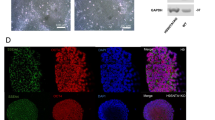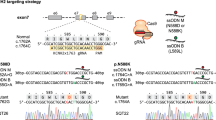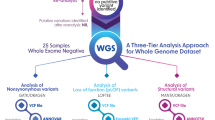Abstract
Sudden infant death syndrome (SIDS) is multifactorial and may result from the interaction of a number of environmental, genetic, and developmental factors. We studied three major genes causing long QT syndrome in 42 Japanese SIDS victims and found five mutations, KCNQ1-K598R, KCNH2-T895M, SCN5A-F532C, SCN5A-G1084S, and SCN5A-F1705S, in four cases; one case had both KCNH2-T895M and SCN5A-G1084S. All mutations were novel except for SCN5A-F532C, which was previously detected in an arrhythmic patient. Heterologous expression study revealed significant changes in channel properties of KCNH2-T895M, SCN5A-G1084S, and SCN5A-F1705S, but did not in KCNQ1-K598R and SCN5A-F532C. Our data suggests that nearly 10% of SIDS victims in Japan have mutations of the cardiac ion channel genes similar to in other countries.
Similar content being viewed by others
Log in or create a free account to read this content
Gain free access to this article, as well as selected content from this journal and more on nature.com
or
Abbreviations
- LQTS:
-
long QT syndrome
References
Krous HF, Beckwith JB, Byard RW, Rognum TO, Bajanowski T, Corey T, Cutz E, Hanzlick R, Keens TG, Mitchell EA 2004 Sudden infant death syndrome and unclassified sudden infant deaths: a definitional and diagnostic approach. Pediatrics 114: 234–238
Scott CL, Iyasu S, Rowley D, Atrash HK 1998 Postneonatal mortality surveillance–United States, 1980–1994. MMWR CDC Surveill Summ 47: 15–30
Martin JA, Kochanek KD, Strobino DM, Guyer B, MacDorman MF 2005 Annual summary of vital statistics–2003. Pediatrics 115: 619–634
Opdal SH, Rognum TO 2004 The sudden infant death syndrome gene: does it exist?. Pediatrics 114: e506–e512
Schneider PM, Wendler C, Riepert T, Braun L, Schacker U, Horn M, Althoff H, Mattern R, Rittner C 1989 Possible association of sudden infant death with partial complement C4 deficiency revealed by post-mortem DNA typing of HLA class II and III genes. Eur J Pediatr 149: 170–174
Opdal SH, Vege A, Stave AK, Rognum TO 1999 The complement component C4 in sudden infant death. Eur J Pediatr 158: 210–212
Opdal SH, Opstad A, Vege A, Rognum TO 2003 IL-10 gene polymorphisms are associated with infectious cause of sudden infant death. Hum Immunol 64: 1183–1189
Narita N, Narita M, Takashima S, Nakayama M, Nagai T, Okado N 2001 Serotonin transporter gene variation is a risk factor for sudden infant death syndrome in the Japanese population. Pediatrics 107: 690–692
Weese-Mayer DE, Berry-Kravis EM, Maher BS, Silvestri JM, Curran ME, Marazita ML 2003 Sudden infant death syndrome: association with a promoter polymorphism of the serotonin transporter gene. Am J Med Genet A 117A: 268–274
Puffenberger EG, Hu-Lince D, Parod JM, Craig DW, Dobrin SE, Conway AR, Donarum EA, Strauss KA, Dunckley T, Cardenas JF, Melmed KR, Wright CA, Liang W, Stafford P, Flynn CR, Morton DH, Stephan DA 2004 Mapping of sudden infant death with dysgenesis of the testes syndrome (SIDDT) by a SNP genome scan and identification of TSPYL loss of function. Proc Natl Acad Sci USA 101: 11689–11694
Kijima K, Sasaki A, Niki T, Umetsu K, Osawa M, Matoba R, Hayasaka K 2004 Sudden infant death syndrome is not associated with the mutation of PHOX2B gene, a major causative gene of congenital central hypoventilation syndrome. Tohoku J Exp Med 203: 65–68
Horiuchi H, Sasaki A, Osawa M, Kijima K, Ino Y, Matoba R, Hayasaka K 2005 Sensitive detection of polyalanine expansions in PHOX2B by polymerase chain reaction using bisulfite-converted DNA. J Mol Diagn 7: 638–640
Priori SG, Barhanin J, Hauer RN, Haverkamp W, Jongsma HJ, Kleber AG, McKenna WJ, Roden DM, Rudy Y, Schwartz K, Schwartz PJ, Towbin JA, Wilde AM 1999 Genetic and molecular basis of cardiac arrhythmias: impact on clinical management parts I and II. Circulation 99: 518–528
Priori SG, Barhanin J, Hauer RN, Haverkamp W, Jongsma HJ, Kleber AG, McKenna WJ, Roden DM, Rudy Y, Schwartz K, Schwartz PJ, Towbin JA, Wilde AM 1999 Genetic and molecular basis of cardiac arrhythmias: impact on clinical management part III. Circulation 99: 674–681
Maron BJ, Clark CE, Goldstein RE, Epstein SE 1976 Potential role of QT interval prolongation in sudden infant death syndrome. Circulation 54: 423–430
Sadeh D, Shannon DC, Abboud S, Saul JP, Akselrod S, Cohen RJ 1987 Altered cardiac repolarization in some victims of sudden infant death syndrome. N Engl J Med 317: 1501–1505
Schwartz PJ, Priori SG, Dumaine R, Napolitano C, Antzelevitch C, Stramba-Badiale M, Richard TA, Berti MR, Bloise R 2000 A molecular link between the sudden infant death syndrome and the long-QT syndrome. N Engl J Med 343: 262–267
Schwartz PJ, Priori SG, Bloise R, Napolitano C, Ronchetti E, Piccinini A, Goj C, Breithardt G, Schulze-Bahr E, Wedekind H, Nastoli J 2001 Molecular diagnosis in a child with sudden infant death syndrome. Lancet 358: 1342–1343
Wedekind H, Smits JP, Schulze-Bahr E, Arnold R, Veldkamp MW, Bajanowski T, Borggrefe M, Brinkmann B, Warnecke I, Funke H, Bhuiyan ZA, Wilde AA, Breithardt G, Haverkamp W 2001 De novo mutation in the SCN5A gene associated with early onset of sudden infant death. Circulation 104: 1158–1164
Ackerman MJ, Siu BL, Sturner WQ, Tester DJ, Valdivia CR, Makielski JC, Towbin JA 2001 Postmortem molecular analysis of SCN5A defects in sudden infant death syndrome. JAMA 286: 2264–2269
Schulze-Bahr E, Fenge H, Etzrodt D, Haverkamp W, Monnig G, Wedekind H, Breithardt G, Kehl HG 2004 Long QT syndrome and life threatening arrhythmia in a newborn: molecular diagnosis and treatment response. Heart 90: 13–16
Brugada R, Hong K, Dumaine R, Cordeiro J, Gaita F, Borggrefe M, Menendez TM, Brugada J, Pollevick GD, Wolpert C, Burashnikov E, Matsuo K, Wu YS, Guerchicoff A, Bianchi F, Giustetto C, Schimpf R, Brugada P, Antzelevitch C 2004 Sudden death associated with short-QT syndrome linked to mutations in HERG. Circulation 109: 30–35
Christiansen M, Tonder N, Larsen LA, Andersen PS, Simonsen H, Oyen N, Kanters JK, Jacobsen JR, Fosdal I, Wettrell G, Kjeldsen K 2005 Mutations in the HERG K+-ion channel: a novel link between long QT syndrome and sudden infant death syndrome. Am J Cardiol 95: 433–434
Arnestad M, Crotti L, Rognum TO, Insolia R, Pedrazzini M, Ferrandi C, Vege A, Wang DW, Rhodes TE, George AL Jr Schwartz PJ 2007 Prevalence of long-QT syndrome gene variants in sudden infant death syndrome. Circulation 115: 361–367
Lin C, Nagai M, Ishigaki D, Hayasaka K, Endoh M, Ishii K 2005 Cross-talk between beta(1)-adrenoceptors and ET(A) receptors in modulation of the slow component of delayed rectifier K(+) currents. Naunyn Schmiedebergs Arch Pharmacol 371: 133–140
Ishii K, Nagai M, Takahashi M, Endoh M 2003 Dissociation of E-4031 from the HERG channel caused by mutations of an amino acid results in greater block at high stimulation frequency. Cardiovasc Res 57: 651–659
Makita N, Horie M, Nakamura T, Ai T, Sasaki K, Yokoi H, Sakurai M, Sakuma I, Otani H, Sawa H, Kitabatake A 2002 Drug-induced long-QT syndrome associated with a subclinical SCN5A mutation. Circulation 106: 1269–1274
Maekawa K, Saito Y, Ozawa S, Adachi-Akahane S, Kawamoto M, Komamura K, Shimizu W, Ueno K, Kamakura S, Kamatani N, Kitakaze M, Sawada J 2005 Genetic polymorphisms and haplotypes of the human cardiac sodium channel alpha subunit gene (SCN5A) in Japanese and their association with arrhythmia. Ann Hum Genet 69: 413–428
Barhanin J, Lesage F, Guillemare E, Fink M, Lazdunski M, Romey G 1996 K(V)LQT1 and lsK (minK) proteins associate to form the I(Ks) cardiac potassium current. Nature 384: 78–80
Sanguinetti MC, Curran ME, Zou A, Shen J, Spector PS, Atkinson DL, Keating MT 1996 Coassembly of K(V)LQT1 and minK (IsK) proteins to form cardiac I(Ks) potassium channel. Nature 384: 80–83
Smith PL, Baukrowitz T, Yellen G 1996 The inward rectification mechanism of the HERG cardiac potassium channel. Nature 379: 833–836
Sanguinetti MC, Jiang C, Curran ME, Keating MT 1995 A mechanistic link between an inherited and an acquired cardiac arrhythmia: HERG encodes the IKr potassium channel. Cell 81: 299–307
Kiehn J, Lacerda AE, Wible B, Brown AM 1996 Molecular physiology and pharmacology of HERG. Single-channel currents and block by dofetilide. Circulation 94: 2572–2579
Warmke JW, Ganetzky B 1994 A family of potassium channel genes related to eag in drosophila and mammals. Proc Natl Acad Sci USA 91: 3438–3442
Sasano T, Ueda K, Orikabe M, Hirano Y, Kawano S, Yasunami M, Isobe M, Kimura A, Hiraoka M 2004 Novel C-terminus frameshift mutation, 1122fs/147, of HERG in LQT2: additional amino acids generated by frameshift cause accelerated inactivation. J Mol Cell Cardiol 37: 1205–1211
Nakajima T, Kurabayashi M, Ohyama Y, Kaneko Y, Furukawa T, Itoh T, Taniguchi Y, Tanaka T, Nakamura Y, Hiraoka M, Nagai R 2000 Characterization of S818L mutation in HERG C-terminus in LQT2. Modification of activation-deactivation gating properties. FEBS Lett 481: 197–203
Bezzina CR, Verkerk AO, Busjahn A, Jeron A, Erdmann J, Koopmann TT, Bhuiyan ZA, Wilders R, Mannens MM, Tan HL, Luft FC, Schunkert H, Wilde AA 2003 A common polymorphism in KCNH2 (HERG) hastens cardiac repolarization. Cardiovasc Res 59: 27–36
Tester DJ, Will ML, Haglund CM, Ackerman MJ 2005 Compendium of cardiac channel mutations in 541 consecutive unrelated patients referred for long QT syndrome genetic testing. Heart Rhythm 2: 507–517
Splawski I, Shen J, Timothy KW, Lehmann MH, Priori S, Robinson JL, Moss AJ, Schwartz PJ, Towbin JA, Vincent GM, Keating MT 2000 Spectrum of mutations in long-QT syndrome genes. KVLQT1, HERG, SCN5A, KCNE1, and KCNE2. Circulation 102: 1178–1185
Priori SG, Napolitano C, Giordano U, Collisani G, Memmi M 2000 Brugada syndrome and sudden cardiac death in children. Lancet 355: 808–809
Wan X, Chen S, Sadeghpour A, Wang Q, Kirsch GE 2001 Accelerated inactivation in a mutant Na(+) channel associated with idiopathic ventricular fibrillation. Am J Physiol Heart Circ Physiol 280: H354–H360
Quaglini S, Rognoni C, Spazzolini C, Priori SG, Mannarino S, Schwartz PJ 2006 Cost-effectiveness of neonatal ECG screening for the long QT syndrome. Eur Heart J 27: 1824–1832
Schwartz PJ 2006 Pro: Newborn ECG screening to prevent sudden cardiac death. Heart Rhythm 3: 1353–1355
van Langen IM, Wilde AA 2006 Con: Newborn screening to prevent sudden cardiac death?. Heart Rhythm 3: 1356–1359
Tester DJ, Ackerman MJ 2005 Sudden infant death syndrome: How significant are the cardiac channelopathies?. Cardiovasc Res 67: 388–396
Acknowledgements
We thank Prof. Atsunori Shinagawa (Department of Biology, Faculty of Science, Yamagata University), for advice on handling Xenopus laevis and its oocytes.
Author information
Authors and Affiliations
Corresponding author
Additional information
Supported in part by grants from the Ministry of Education, Culture, Sports, and Science, Japan.
Rights and permissions
About this article
Cite this article
Otagiri, T., Kijima, K., Osawa, M. et al. Cardiac Ion Channel Gene Mutations in Sudden Infant Death Syndrome. Pediatr Res 64, 482–487 (2008). https://doi.org/10.1203/PDR.0b013e3181841eca
Received:
Accepted:
Issue date:
DOI: https://doi.org/10.1203/PDR.0b013e3181841eca
This article is cited by
-
Feasibility of analysis of the SCN5A gene in paraffin embedded samples in sudden infant death cases at the Pretoria Medico-Legal Laboratory, South Africa
Forensic Science, Medicine and Pathology (2018)
-
Molekulare Autopsie nach plötzlichem Herztod
Rechtsmedizin (2018)
-
Sudden infant death syndrome due to long QT syndrome: a brief review of the genetic substrate and prevalence
Journal of Biological Research-Thessaloniki (2017)
-
Sudden infant death syndrome and inherited cardiac conditions
Nature Reviews Cardiology (2017)
-
Postmortem genetic analysis of sudden unexpected death in infancy: neonatal genetic screening may enable the prevention of sudden infant death
Journal of Human Genetics (2017)



